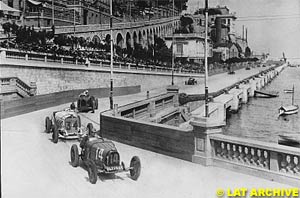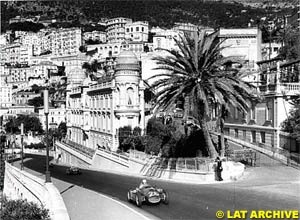
Atlas F1 Contributing Writer
The Monaco Grand Prix is undoubtedly the most charismatic and glamorous race of the Formula One calendar, with all the casinos, the celebrities, and Monegasques offering friendship with one hand extended. Journalist and historian Doug Nye looks at the unique atmosphere of the Principality and also reviews the changes to the Monte Carlo circuit throughout the years
As a wintertime retreat for the elderly but wealthy, Monte Carlo, was - I thought - simply lovely. At Monte Carlo Rally time - for this was it - there was enough life about the place to make it interesting. It seemed a charming town, splattered across the shoreline slopes like a freshly-hurled custard pie. And then there were the Monegasques, offering friendship with one hand extended. Pay for this, pay for that, for politeness, pay for respect, pay for service, pay, pay, pay.
But then there's the other Monaco and Monte Carlo - the classic round-the-houses Grand Prix circuit on which so very much motor racing history has been written. There's no point in repeating here the familiar litany of bygone winners and losers, their success and failure, it's all so well known - so often listed - so easy to access, not least right here on the net. In modern times the venue has looked increasingly like a displaced person - an ill-fitting throwback to bygone times, unsuited to modern Formula One cars, a venue on which grid position can mean everything, a poor qualifying period and a team and driver might just as well pack up right now and return home.
Like the Monte Carlo Rally, the Monaco Grand Prix was a device to enhance tourism to the Principality, underwritten and backed absolutely by the most powerful corporation in town, the Casino-owning Societe des Bains de Mer.
It had to make commercial sense of course - remember the Monegasques, offering friendship with one hand extended, fingers open, palm uppermost. Pay for this, pay for that, pay for politeness, pay for respect, pay for service, pay, pay, pay.
Anthony Noghes was founder-President of the Automobile Club de Monaco, and he had delineated a possible round-the-houses circuit in his own mind during the mid-1920s. Backed by former racer Francis Dureste he took his ideas to Rene Léon, executive head of the all-powerful Societe des Bains de Mer. He gave them an enthusiastic reception and the notion eventually won the vital backing of the Prince to launch the Monaco Grand Prix in 1929.
The course was chosen with its startline more or less at the present site, on the Boulevard Albert Premier, immediately inland from the harbour quayside which would complete the return leg. The whence it soared steeply uphill, climbing some 40-50 metres - 120-150 feet - above quay level to enter the Casino Square.
Left-right through a chicane onto the harbour-side Quai des Etats-Unis, hard left at the daunting Tabac turn with its unyielding stone steps and wall to the right, and then blast round the long, lazy, left-hand curve of the Quai Albert Premier, parallel to the start and finish 'straight', reached via the impossibly tight (though wide) final right-hand hairpin by the town Gasworks.
Within the context of the 1920s this all worked rather well. The Monegasques found thousands of fresh visitors, happy to pay, pay, pay, and 'Williams' scored his celebrated maiden Monaco victory for Bugatti. Ever since - albeit with a series of pretty substantial hiccups along the way, only one of them caused by world war - this celebrated race has been part of the worldwide sporting public's consciousness.
For many years the course survived in its original form. The startline moved to the quayside with the Gazometre hairpin the first corner until this proved to be a dumb idea - while the chicane's siting shuttled to and from for years.
Alberto Ascari celebratedly dropped his Lancia D50 into the harbour there in 1955, and Australian Paul Hawkins repeated the trick with Dickie Stoop's privately-entered Lotus 33 in 1965. In 1967 Ferrari's Italian star Lorenzo Bandini suffered fatal burns in an horrific accident at the chicane.
He had been visibly tiring in the cockpit as the long, hot, arduous 100-lap race wore on, and after 82 laps made his fatal error of judgement. The race distance was slashed to 80 laps thereafter.
Track changes were made as Monte Carlo itself changed shape at the hands of the developers. The railway was grubbed up, the station torn down, cost-effective new toast-rack tower buildings replaced the traditional cake-icing. The Loews Hotel replaced the station, the Quai Albert premier was realigned around a brand-new Olympic-standard al fresco swimming pool, the course remodelled around it, the loop around the Rascasse restaurant obliterating the old Gazometre area. The start returned to its original situation in front of the AC de Monaco clubhouse. But the Monegasque attitudes never changed - Pay for this, pay for that, pay for politeness, pay for respect, pay for service, pay, pay, pay. Pay and I'll be your friend. Quibble, haggle, object…prove difficult and I'll be your enemy. Until you say 'Boo!'…in my experience an unimpressive bunch.
Minor-Formulae, sports car and motor-cycle races provided support to the Grand Prix, followed by one-make Procars, Jaguars, Renault saloons, Porsche Cup, Formula 3000, Historics/hysterics…anything that might pay or attract major-league sponsorship.
Monaco was not afflicted by mere vulnerabilities, but also in pure motor racing terms by almost impossible restrictions. To drive round the Principality's circuit in race-trim today is to feel like the ball in a pin-board game, confined in a streaming funnel of never-ending Armco - jouncing over the huge heavy steel plate kerbs which are bolted down onto the apex points of the chicanes - the peculiar non-tunnel of today's covered gallery - squared modern arches flickering by to the left, wide open to sun and sea-air, and the fantastically narrow final run from the last swimming pool left-hander into the right-handed loop at Rascasse.
And of course there are still the unchanging Monegasques. Pay for this, pay for that, pay for politeness, pay for respect, pay for service, pay, pay, pay. Pay and I'll be your friend…
But great drives there have been here in plenty, outweighing the poor ones, the stupidities of the place, and the visual and aesthetic setting is still supreme, while the noise - in intensity if not in full-throttle duration - is always the most impressive in the game, racketing back from walls and cliffs and mountainsides alike. But qualifying is the key, absolutely crucial - with mechanical reliability of brakes and transmission particularly close behind. Survive to the finish at all and there's a chance of scoring points, then head for the Heliport tout-de-suite, to shake off the Monegasques with their right hands still, always, relentlessly, outstretched…
The first few times I went to Monaco I thought it was simply tremendous. It was January, the depths of the European winter. The snows lay deep up in the Alpes Maritimes, the Col de Turini road was packed hard with gleaming, threatening sheet ice, and then as you plummeted down through the hairpins and pines the temperature soared, and here we were in the Grimaldi family's alleged jewel of the Mediterranean.
 Hmm, perhaps not quite so lovely as I'd thought. Then I parachuted in at Grand Prix time. The wintertime resort - temporarily busied by the rally circus - had been transformed into a dazzling, jam-packed, glittering fuzzball of the rich, the famous, the international celebrity, the B-list celebrity, the forgotten once-I-was-a-celebrity and the thousands of I'll-kill-to-be-a-celebrity wannabes. As the ultimate passenger list for the hairdressers' spacecraft - consigned forever to coast fruitlessly away through the outermost arm of the galaxy, Monaco had it all. And then there were the Monegasques, offering friendship with one hand extended. Pay for this, pay for that, pay for politeness, pay for respect, pay for service, pay, pay, pay.
Hmm, perhaps not quite so lovely as I'd thought. Then I parachuted in at Grand Prix time. The wintertime resort - temporarily busied by the rally circus - had been transformed into a dazzling, jam-packed, glittering fuzzball of the rich, the famous, the international celebrity, the B-list celebrity, the forgotten once-I-was-a-celebrity and the thousands of I'll-kill-to-be-a-celebrity wannabes. As the ultimate passenger list for the hairdressers' spacecraft - consigned forever to coast fruitlessly away through the outermost arm of the galaxy, Monaco had it all. And then there were the Monegasques, offering friendship with one hand extended. Pay for this, pay for that, pay for politeness, pay for respect, pay for service, pay, pay, pay.
 Squeezing through between the cake-icing architecture of the Hotel de Paris on the left and the Casino on the right, the chosen roadway then plunged downhill on a brief and steeply falling straight into the more than 90-degree right by the Hotel Mirabeau. Wiggle briefly down to the still-plunging, left-hand hairpin at the railway station, down right-handed beneath the railway viaduct to the ninety-right Portier Corner on the sea-front - where the breakers roll right in beneath the roadway to break in a rock-strewn cove - and then squirt away on the level, curving right-handed to the Tir aux Pigeons, a fully-enclosed stone-lined true tunnel in those days, before popping out into the open to commence another mild descent towards the harbour quays on the Quai Louis II.
Squeezing through between the cake-icing architecture of the Hotel de Paris on the left and the Casino on the right, the chosen roadway then plunged downhill on a brief and steeply falling straight into the more than 90-degree right by the Hotel Mirabeau. Wiggle briefly down to the still-plunging, left-hand hairpin at the railway station, down right-handed beneath the railway viaduct to the ninety-right Portier Corner on the sea-front - where the breakers roll right in beneath the roadway to break in a rock-strewn cove - and then squirt away on the level, curving right-handed to the Tir aux Pigeons, a fully-enclosed stone-lined true tunnel in those days, before popping out into the open to commence another mild descent towards the harbour quays on the Quai Louis II.
 And as Monaco became firmly established as the sponsors' most favoured - most business-effective, influential-freebie Formula One venue, so it became cemented into the very fabric of modern Formula One. When the self-confident Monaco club saw things differently to the FISA/FOCA axis, suggestion of running the race weekend for CART quickly saw agreement confirmed with Formula One. Yet in 1969 and again in 1975 - after wing collapses in the preceding Spanish GP at Barcelona had eventually caused collateral damage in bystander fatalities - the powers-that-were saw fit to condemn the Spanish city's Montjuich Park as being intolerably dangerous, while turning a tacit blind eye to Monte Carlo's similar vulnerabilities. Ban it, abandon it, no way! The sponsors would never stomach it…
And as Monaco became firmly established as the sponsors' most favoured - most business-effective, influential-freebie Formula One venue, so it became cemented into the very fabric of modern Formula One. When the self-confident Monaco club saw things differently to the FISA/FOCA axis, suggestion of running the race weekend for CART quickly saw agreement confirmed with Formula One. Yet in 1969 and again in 1975 - after wing collapses in the preceding Spanish GP at Barcelona had eventually caused collateral damage in bystander fatalities - the powers-that-were saw fit to condemn the Spanish city's Montjuich Park as being intolerably dangerous, while turning a tacit blind eye to Monte Carlo's similar vulnerabilities. Ban it, abandon it, no way! The sponsors would never stomach it…
Please Contact Us for permission to republish this or any other material from Atlas F1.
|
Volume 8, Issue 21
Atlas F1 Exclusive
Exclusive Interview with Nick Heidfeld
Jo Ramirez: a Racing Man
Articles
The Rubens Factor
Picking Panis
GP Preview
The 2002 Monaco GP Preview
Local History: Monaco
Monaco Facts & Stats
Columns
The Monaco Trivia Quiz
Bookworm Critique
Elsewhere in Racing
The Weekly Grapevine
> Homepage |